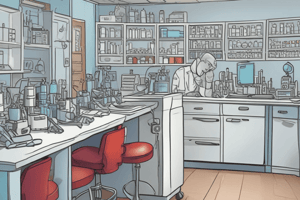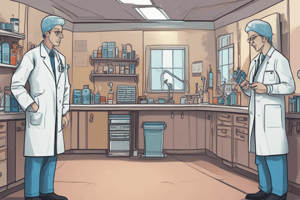Podcast
Questions and Answers
During the patient registration process, what is the phlebotomist's role?
During the patient registration process, what is the phlebotomist's role?
- To verify the patient's identity and ensure accurate information (correct)
- To collect the blood specimen
- To prepare the labelling of specimens
- To administer medications to the patient
What should the phlebotomist do when approaching the patient?
What should the phlebotomist do when approaching the patient?
- Start collecting the blood specimen immediately
- Check the patient's medical history
- Identify themselves and state their purpose (correct)
- Ask the patient to identify themselves
What are the two main identifiers used for patient identification?
What are the two main identifiers used for patient identification?
- Patient's full name and SID Number (correct)
- Patient's address and contact number
- Patient's full name and date of birth
- Patient's medical history and allergies
When should the specimens tubes be labelled?
When should the specimens tubes be labelled?
What should the phlebotomist do if any discrepancies are identified during the patient identification process?
What should the phlebotomist do if any discrepancies are identified during the patient identification process?
What is the primary purpose of this manual?
What is the primary purpose of this manual?
What is included in the standard precautions for handling laboratory specimens?
What is included in the standard precautions for handling laboratory specimens?
What is the term for the act of drawing or removing blood from the circulatory system through a puncture?
What is the term for the act of drawing or removing blood from the circulatory system through a puncture?
What should be done with contaminated items such as gloves and tourniquets?
What should be done with contaminated items such as gloves and tourniquets?
Why is recapping a used needle not recommended?
Why is recapping a used needle not recommended?
What type of respirator should be used when respiratory protection is needed?
What type of respirator should be used when respiratory protection is needed?
Flashcards are hidden until you start studying
Study Notes
Vascular Access Devices (VAD)
- A device inserted temporarily or permanently into a vein and/or artery to allow access to the circulatory system.
Blood Specimen Collection Process
- Patient registration is the first step in the process, where proper patient identification begins.
- The collector must check the test request, ensuring accurate information, and observe the patient's details, including signage, bracelets, and IV lines.
Patient Identification
- Patients are actively involved in the identification process and educated on its importance.
- The phlebotomist must ensure the blood specimen is drawn from the right patient.
- The two main identifiers are the patient's full name and SID Number.
- Any discrepancies are identified and resolved before collecting the specimen.
Labelling of Specimens
- Specimens tubes must be labelled before collecting samples and in the presence of the patient.
- Labels must be applied to the tubes in a manner that ensures all information is visible.
- Barcode labels are generated from the software, and manual labelling requires verification of information.
Pre-collection Requirements
- The phlebotomist must comply with all pre-collection requirements, including standard precautions.
Standard Precautions
- All patients and laboratory specimens are treated as infectious and handled according to standard precautions.
- Personal protective equipment (PPE) includes gloves, close shoes, masks, and lab coats.
- Hand hygiene practices involve using hand rub in between patients with gloves.
- Follow waste management practices and maintain a clean work environment.
- Adhere to safety needle use, and recapping a used needle is not recommended.
- Respiratory protection is needed when exposed to infectious agents, using triple layer masks or filter respirators (N-95 or higher).
Studying That Suits You
Use AI to generate personalized quizzes and flashcards to suit your learning preferences.




